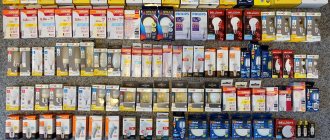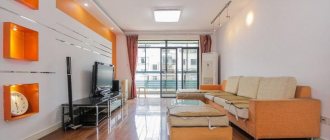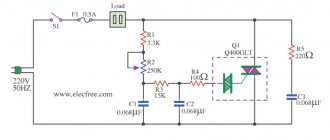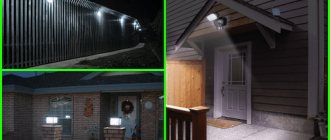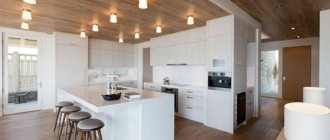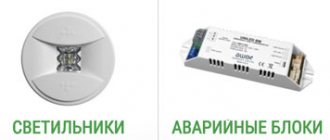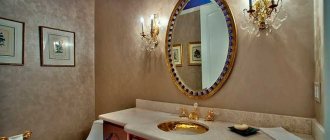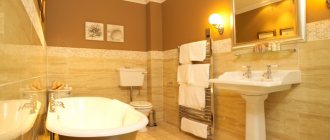The requirements for arranging a lighting system in a bathroom reflect the specifics of the room. Due to the lack of windows in most rooms, the role of artificial light sources and their proper placement increases. Lighting in the bathroom should be bright and diffuse, emphasizing the interior items and creating coziness.
A system of lamps and LED devices performs additional functions, decorating the interior and visually expanding a small area. When installing devices, it is imperative to comply with safety requirements.
Choosing a lamp for the bathroom
Before choosing lamps, you need to determine color combinations and the style of decorating the room. The type of lamps, their design and installation methods are influenced by the number of functional spaces and the dimensions of the room.
Bathroom lamp
Bathroom appliances are divided into types.
- Depending on the level of location, you can choose among floor, ceiling, and wall devices.
- Features of placement on the surface determine open and built-in models.
Functional zoning provides space above a cabinet or mirror, door or bathroom, etc.
Different lamps are installed in the lamps.
- halogen;
- luminescent;
- LED;
- metal halide.
Standard incandescent lamps are also popular. Depending on the scope of use, lamps are distinguished for general use, with directional or decorative functions.
The choice of lighting fixtures is carried out in accordance with the color combinations of the room. In rooms with orange, red, yellow-green colors, lamps in warm shades of white can be used.
Interiors in cool colors require LED, fluorescent, metal halide fixtures and neutral white lamps.
- color temperature for the range of green tones – 3300-4000 K;
- green-blue shades will require 4000 K;
- for rooms in blue tones, 4000-5000 K is required.
You need to choose lamps that can operate in constant humidity conditions. These are devices with a degree of protection against proximity to water of IP24. In the shower cabins there are ceiling lamps with a low voltage rating of up to 12 V. Lamps with only protection class 2 are installed 60 cm from the bathtub.
Why should you use LED lamps?
Compared to other artificial lighting sources, LED lamps deserve the highest rating. Their superiority when organizing lighting in the bathroom is in the following points:
LED lamps are completely interchangeable with all known types of light bulbs, as they are manufactured for all types of sockets. Taking into account this fact, switching to LED lighting in a bathroom that has already undergone a major renovation will not be difficult. The temperature of the body of a high-quality LED light bulb does not exceed 80°C, and the body of the lamp itself with such a lamp remains cold or barely warm. As a result, overheating and subsequent yellowing of the ceiling sheet are eliminated. You don’t have to be afraid to use any type of spotlights. In addition to the usual standard voltage of 220 V, light sources are commercially available that are designed for a voltage of 12 V (safe for lighting rooms with high humidity). LED lamps can be produced without the use of glass and, unlike incandescent and halogen lamps, do not explode when switched on at high voltage. Based on personal taste and the color of the interior trim, you can choose LED lamps with the most suitable shade of white light. The high efficiency of light sources based on LEDs has made it possible to reduce the size of LED lamps and luminaires
Compact and at the same time bright lamps not only emphasize style, but also save space, which is important for small bathrooms.
Lighting scheme
To properly organize a complex of lighting devices, a number of conditions must be met. It is necessary to develop options for lamp placement schemes before carrying out repair work. For cables under point light sources, plasterboard false beams will be required.
The bathroom lighting scheme involves several types of lamps and structures, sockets and switches. To create a system of devices, you will need to correctly connect them with wires. The laying of electrical circuits is carried out taking into account the characteristics of the room: constant air humidity, proximity to water.
Possible lighting diagram
In bathroom design there is a tendency to reduce the functional load on the ceiling in the center. Schemes of dynamic arrangement of lamps of different sizes throughout the room are proposed. Lighting in a bathroom with a suspended ceiling involves complex connection patterns for many types and sizes of lamps.
Schemes for arranging decorative lighting are carried out taking into account a number of requirements. The elements must be positioned correctly relative to the wall mirrors. To design the lighting level in an original way, use a scheme for placing light sources along the contour of the mirror.
Spot location rules
True, in order to squeeze the maximum aesthetic appeal from the mounted panel, you need to know the basic rules for the safe placement of spots on a stretch ceiling. Let's try to list below those that are considered basic:
- if the spots are located along the wall, then maintain the minimum distance required for high-quality light dispersion - 20 cm. If you ignore this recommendation, you will not be able to get the level of illumination you want from the mounted lamps;
- the recommended distance between spots is from 30 centimeters, the optimal one is determined by local need and the type of stretched panel;
- parallel placed spotlights visually lengthen the room - this can be successfully used for rooms that need some visual correction;
- a rectangular arrangement is ideal for small and narrow rooms, but most often requires support in the form of “heavy artillery” - a weighty chandelier in the center;
- if you use spots in connection with stretch ceilings made of ordinary PVC film, then the maximum permissible power for halogen lamps is up to 20 W, for a satin panel a little more - up to 35 W;
- the exact number of lamps is always determined by the type of light pattern in the room, but one spot can illuminate no more than 2 m2 of free area. This figure must be kept in mind when drawing up a plan for the placement of spotlights on a suspended ceiling.
Lighting power
For a bathroom, the power of lighting devices is important. Low-voltage models are suitable for the room.
- The power of standard lamps should be 20-30 W/m².
- Requirements for halogen lamps – 23-28 W/m².
- For daylight devices, a power of 6-9 W/m² is sufficient.
The choice of lamp brightness also depends on the color scheme of the room. Finishing in light colors requires less power; dark colors require more intense lighting.
Systems with high power lamps are installed with grounded contacts. It is optimal to place such devices near the doorway, because... the risk of water entering the area is minimal.
Number of lamps
The number of light sources is influenced by the dimensions of the room. Experts recommend calculating the location and required volume of lamps at the beginning of repair work.
It is necessary to determine the area of the room and the number of areas for lighting. Even small rooms of 6 square meters. m are divided into 3 functional zones:
- bathing area with shower;
- wash area with sink;
- area for changing clothes and washing.
Section 2 requires the highest brightness - up to 600 lux. To install lamps on the main ceiling, devices of different shapes and power are required.
Spacious bathrooms require zone lighting, which includes a large number of lamps depending on the configuration of the room and the design idea.
The determining factors include the style and color scheme of the room. A room in light colors looks more illuminated, as does a bathroom with glossy and mirrored surfaces.
The number of devices is affected by the type of lamps. The height of the ceiling is also important, because... In spacious rooms additional lamps will be required.
Connecting point models
Twelve-volt light models are connected via a transformer. The connection is parallel. To calculate the number of sources, you need to find out the power of the transformer.
Conversely, purchasing a transformer begins with calculating the number of point sources and finding out their power. The transformer power is calculated with a reserve.
Position light sources
Before placing lamps in the bathroom, it is recommended to determine the number of functional spaces. The wide rooms have several levels.
- wash areas with a sink and mirror are designed;
- area for water treatments with shower or jacuzzi;
- space for changing clothes and placing things.
Small built-in lamps with a gentle light also illuminate furniture structures - shelves, cabinets, cabinets.
The location of lighting fixtures at the ceiling level depends on the size of the room. It is important to calculate the dimensions of the room in order to determine the best layout, but which arrangement is more harmonious will also depend on the design solution. Lighting can be represented by 1 lampshade or a complex combination of lamps of different types.
Combining lighting systems at different levels is popular. The basic principles of bathroom design involve lighting the work area, which includes a mirror, washbasin, and shelves.
Preference is for unobtrusive soft light. Lower lighting often serves as interior decoration. Such lamps are placed 40 cm from the floor or on the lower surface and under interior items. It is possible to place light sources on the steps and under the podium.
Washbasin and mirror lighting
The middle level includes the installation of lighting fixtures above the bathroom mirror and washbasin. The requirements for the devices are to create natural light, a clear image on the glass surface - without distortion or shadows.
Rotary and non-rotating devices
Directional light allows you to find the right solutions in lighting different areas. For this reason, rotary models are often used as targeted sources. They are distinguished by a relatively simple design - the body of the device is fixed in the inter-ceiling surface, and its outer part rotates.
The device can rotate in different directions and direct a beam of light to a specific area. It is used to highlight the bathtub, shower stall, sink and vanity.
This type of lamp is perfect for emphasizing individual bright elements of the interior - it will effectively display a unique vase, an attractive panel or an original floral arrangement.
Rotating models are characterized by the presence of a special movable design with a lamp that can adjust the light flux and direct
Fixed devices are distinguished by their stationary mounting and targeted lighting. When they are turned on, the light rays are directed in one direction, usually downwards.
In order to rationally distribute the light emanating from fixed models, they are installed in groups. The devices are placed in a line, in a circle or in some other way. Their number depends on the area of the room.
Spot models in which specific light bulbs are installed are compact. According to their design, they are divided into protruding from the ceiling surface and hidden in the ceiling suspension system.
Electrical appliances recessed into the bathroom ceiling are suitable for any interior design, but they provide less light. The light flow is directed clearly downwards and only a small area located under the device is illuminated.
Bathroom lamps can be used with different electric lamps. When choosing them, the design characteristics of the products are taken into account
Safety
The combination of electricity and moisture is possible only under special conditions, so when organizing lighting it is important to ensure the safe operation of the devices. When choosing lamps, it is necessary to check the degree of protection from moisture and dust. Electrical wiring is installed taking into account electrical safety standards and regulations.
Distribution boxes are not placed inside the bathroom due to high humidity. In the connecting devices that are laid out according to the diagram, it is required to perform insulation in accordance with safety standards. The devices are protected with moisture-proof terminal blocks.
Safe operation of the system is ensured by connection to grounding devices. When installing lamps, it is necessary to install protective devices - RCDs. The equipment detects current leakage and, if a violation is detected, automatically turns off the electricity supply.
It is important to separate lighting fixture sets when installing wiring. To ensure safety, sockets are mounted separately from lighting systems and powerful electrical devices. Subsystems must be equipped with their own protection - circuit breakers.
How to install it yourself?
To begin with, it’s worth deciding on some important points regarding electrical wiring.
- The voltage should be low - 12 V.
- The distribution box should be located outside the bathroom.
- It is important to minimize the number of high voltage cable connections.
Approximate installation diagram of a spotlight with a transformer.
Now let’s take a look at the step-by-step installation instructions.
Step one. To begin with, a “garland” is mounted from electrical wiring, to which the spotlights themselves will be connected in the future.
Connection diagram for recessed lamp
After all the wires have been laid, the suspended ceiling is installed. Next, holes are carefully cut out in it corresponding to the diameter of the lamps and the wires are carefully routed out and connected to the terminals of the lamp
Step two. It is necessary to make holes in the ceiling in the right places for the lamps. For cutting, the example uses a diamond-coated hole saw. A crown is installed on an electric drill or screwdriver. After applying the markings, you can begin cutting out holes in the appropriate places.
The location of the lamp is marked
Drill or screwdriver bits
A hole is made
Step three. The diameter of the crown is selected as accurately as possible, otherwise the hole will not fit the lighting fixture. By the way, crowns are bought in sets, and therefore you need to choose an option that matches the diameter of the lamp body.
We turn off the electricity at the installation site. To do this, in the electrical panel, it is necessary to switch the circuit breaker levers to the “Off” state, usually this is the position in which the lever is pointing down
Step four. The wire laid earlier is removed from the hole to connect the lighting fixture.
Getting the power wires
Step five. Instead of traditional sockets, the described lamps have a terminal connector (usually included in the kit), which is a pair of wires that must be connected to phase and neutral. Good insulation is very important here.
Wires are fixed in the terminal block
Power wires are attached to the terminal block
Step six. After this, the lamp itself is installed. Its clamping antennae are unclenched and held, then a wire is threaded through the middle and the device is inserted into the cut hole. Then, when the antennae are released, the lamp will automatically fix itself in the required place. All you have to do is fix it.
Prices for LED lamps
LED lights
Spring fastenings on the body
Spring fasteners bend
The light fits into the installation hole
After this, you need to remove the cartridge from the niche, which we have already connected to the power wire
Step seven. The lamp is secured with an expanding locking ring. It must be removed from the device before installing the lamp.
Expanding retaining ring
Step eight. The lamp is inserted and checked for functionality (just press the switch).
Lamp installation
Step nine. If everything is in order, then the device is finally fixed.
The fixing ring is installed in the groove
It is important to do everything carefully, carefully and in full accordance with the manufacturer's instructions.
Important! When installing the lamp, do not touch its surface with your bare hands, then it will last you much longer
Video – Waterproof lamp “Phillips”
Conclusion
Lamp systems will help create a cozy, warm atmosphere. It is important to determine the type, power, and color scheme of devices in order to organize light in the bathroom.
The devices are multifunctional and create lighting sources and help in interior decoration. Before making lighting, it is necessary to develop diagrams, think through the security system of devices and wiring cables.
When arranging lighting in the bathroom with your own hands, you must follow safety precautions during installation work. The bathroom is the most dangerous place for electrification, which can be protected by protective grounding.
When conducting wiring, a hidden system is used. Sockets are placed at a safe distance from water supplies. In the future, careful operation of the devices is required.
Plastic panels
One of the popular materials used for finishing ceilings is polyvinyl chloride (PVC) panels. They have their advantages and disadvantages, but the main advantage is that they allow you to embed light sources. We’ll talk about how to do this and how to arrange the lamps in this article.
Plastic is an inexpensive type of finishing for ceilings. Installation of PVC panels does not require special skills, and anyone who owns a tool can install a plastic ceiling at home with their own hands.
The range of PVC panels makes it possible to choose products to suit your taste, harmonizing with the interior of the room. The choice of plastic coverings is wide; they are available in various types:
- ceiling-mounted, lightweight and elastic, but requiring careful handling during installation;
- wall, hard and heavy;
- glossy, varnished;
- with thermofilm decor;
- textured like wood, marble, etc.;
Plastic panels are made in various sizes, take this into account when purchasing materials. An important advantage of plastic is its moisture resistance; it can be easily washed by any means. Installation of plastic panels is carried out in bathrooms and toilets; they are used to decorate loggias, verandas and saunas. Plastic options are available with a beautiful coating and texture, and the panels will decorate even an expensive interior.
Plastic panels
PVC boards differ in how they decorate the surface with a pattern. Simple and economical - white, smooth, without a specific pattern and plain. Coating options of other colors and textures are available, which are applied in two ways:
- transferring the ornament from the thermal film base to the PVC panel, this method is simple and economical;
- direct printing, allowing you to obtain a high-resolution design with a rich color gamut. It is done on special equipment.

